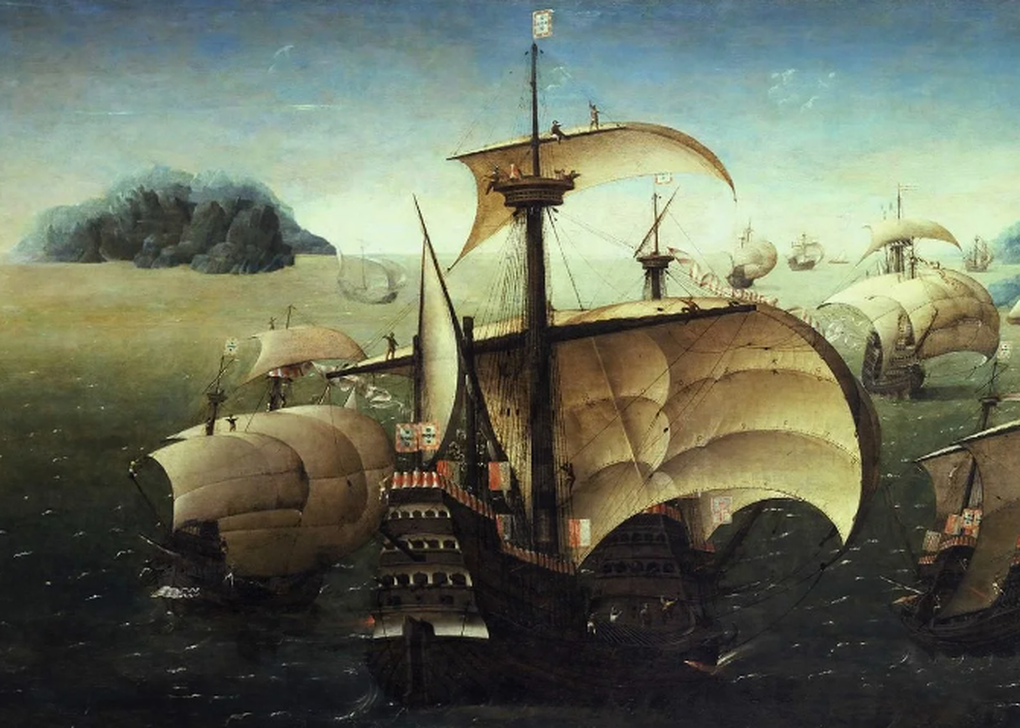Over the centuries, many efforts have been made to find the shipwreck and its enormous treasure, but so far, no one has succeeded.

The Flor de la Mar ship in a painting (Photo: Public Domain).
Advertising by DTads
Although humans have been on Earth for about 200,000 years, there are still many lost treasures out there that we have not been able to find. Among all the locations, the bottom of the ocean is probably the place with the most treasures.
According to the United Nations (UN), it is estimated that there are at least 3 million shipwrecks and their bodies are still lying on the ocean floor. Identifying and salvaging these wrecks could bring great historical significance, or even reveal priceless treasures.
The most famous of them is probably Flor de la Mar – a ship carrying a lot of treasure, sunk to the bottom of the sea more than 500 years ago.
Pride of the Portuguese navy
According to Discovery’s description, this ship is about 36 meters long, weighs 400 tons, and was built in 1502 in the Portuguese capital Lisbon. The ship can carry a crew of about 500 people and is equipped with 50 cannons.
Nicknamed “Flower Of The Sea”, the Flor de la Mar participated in a number of military campaigns during its 9 years of service in the Portuguese fleet.

Throughout the centuries, many efforts have been made to find the shipwreck and its enormous treasure, but so far, no one has succeeded (Illustration: Getty).
Flor de la Mar embarked on her first voyage in 1502 under the command of Estevão da Gama, a Portuguese navigator and explorer. During this time, the ship is said to have discovered the Trindade and Martim Vaz islands (in present-day Brazil).
During the return trip, the ship encountered some problems while crossing the waters near the island of Mozambique. Witnesses at the time said the ship lost many screws into the sea, and was forced to anchor on the island for repairs.
The Flor de la Mar then returned to India under the command of general Jõao da Nova as part of the Portuguese Indian fleet. On the return trip, the ship again encountered problems, and was forced to anchor on the island of Mozambique for about 10 months for repairs.
In 1510, under the command of the legendary general Afonso de Albuquerque, the ship participated in the conquest of the coastal cities of Curiati, Khor Fakkan and Ormuz, and collected wealth and treasure from all over the world. it passes.
It is worth mentioning that before that, the Flor de la Mar ship was seriously degraded due to many repairs, so much so that the ship’s sailing was considered reluctant.
Huge treasure sunk to the bottom of the ocean
On November 20, 1511, the ship encountered a big storm while passing through the northeast sea of Sumatra island, Indonesia.
Records show that the crew tried to find shelter during the storm, but the heavy load caused the ship to lose control, then crash into a shallow beach, splitting in half, before sinking to the bottom of the sea.

The ship Flor de la Mar contains many priceless treasures (Illustration: Getty Images).
It is estimated that about 400 people were killed. However, Afonso de Albuquerque and several others were lucky to survive. However, all the huge treasure contained on the ship was lost, and no one has found it until now.
Some documents say that the Flor de la Mar ship then carried nearly 80 tons of gold, 200 chests filled with diamonds, rubies, emeralds, coins, perfume, jewelry…
These include some extremely rare treasures, such as the gold bracelet of the Rajah of Sabandar, four life-size lions made of solid gold, and maps leading to the treasure painted in hand.
All of these antiques, along with the value of the ship, are estimated by Discovery to be about 2.5 billion pounds.
Over the centuries, many efforts have been made from the Portuguese government to treasure hunting organizations to locate the shipwreck and its huge fortune. However, so far, no one has succeeded.
Many theories suggest that the treasure may have been buried under sediment on the seabed, making the search extremely difficult.











